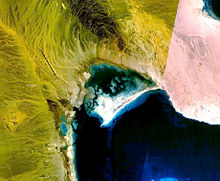Βερενίκη | |
 Satellite image of Berenice Troglodytica, on the Red Sea coast | |
| Alternative name | Berenice Troglodytica, Baranis, Berenike[1] |
|---|---|
| Location | Red Sea Governorate, Egypt |
| Region | Upper Egypt |
| Coordinates | 23°54′31″N 35°28′21″E / 23.90861°N 35.47250°E |
| Type | Settlement |
| History | |
| Builder | Ptolemy II |
| Founded | First half of the 3rd century BCE |
| Abandoned | After the 6th century CE |
| Periods | Ptolemaic Kingdom to Byzantine Empire |
Berenice Troglodytica, also called Berenike (Greek: Βερενίκη) or Baranis, is an ancient seaport of Egypt on the western shore of the Red Sea. It is situated about 825 km south of Suez, 260 km east of Aswan in Upper Egypt and 140 km south of Marsa Alam.[2] It was founded in 275 BCE by Ptolemy II Philadelphus (285–246 BCE), who named it after his mother, Berenice I of Egypt.[3]
A high mountain range runs along the African coast and separates the Nile Valley from the Red Sea; Berenice was sited upon a narrow rim of shore between the mountains and the Red Sea, at the head of the Sinus Immundus,[4] a south-facing bay sheltered on the north by a high peninsula then called Lepte Extrema, and to the south by a chain of small islands scattered across the mouth of the bay. One of them was called the Island of Ophiodes (Ὀφιώδης νήσος[4][5]) and was one of a few sources of gemstones local to Berenice. The harbour is marginal, but was improved by engineering.
- ^ Final Report for 5th season - Pattanam Excavation (PDF) (Report). Tiruvananthapuram, India: Kerala Council for Historical Research. 2011. Archived from the original (PDF) on 7 August 2015. Retrieved 13 September 2015.
- ^ Cite error: The named reference
pcma-2019-04-17was invoked but never defined (see the help page). - ^ Michael Peppard (2009). "A letter concerning boats in Berenike and trade on the Red Sea." Zeitschrift für Papyrologie und Epigraphik, Bd. 171, p. 196.
- ^ a b Strabo xvi. p. 770;[full citation needed]
- ^ Diod. iii. 39[full citation needed]

